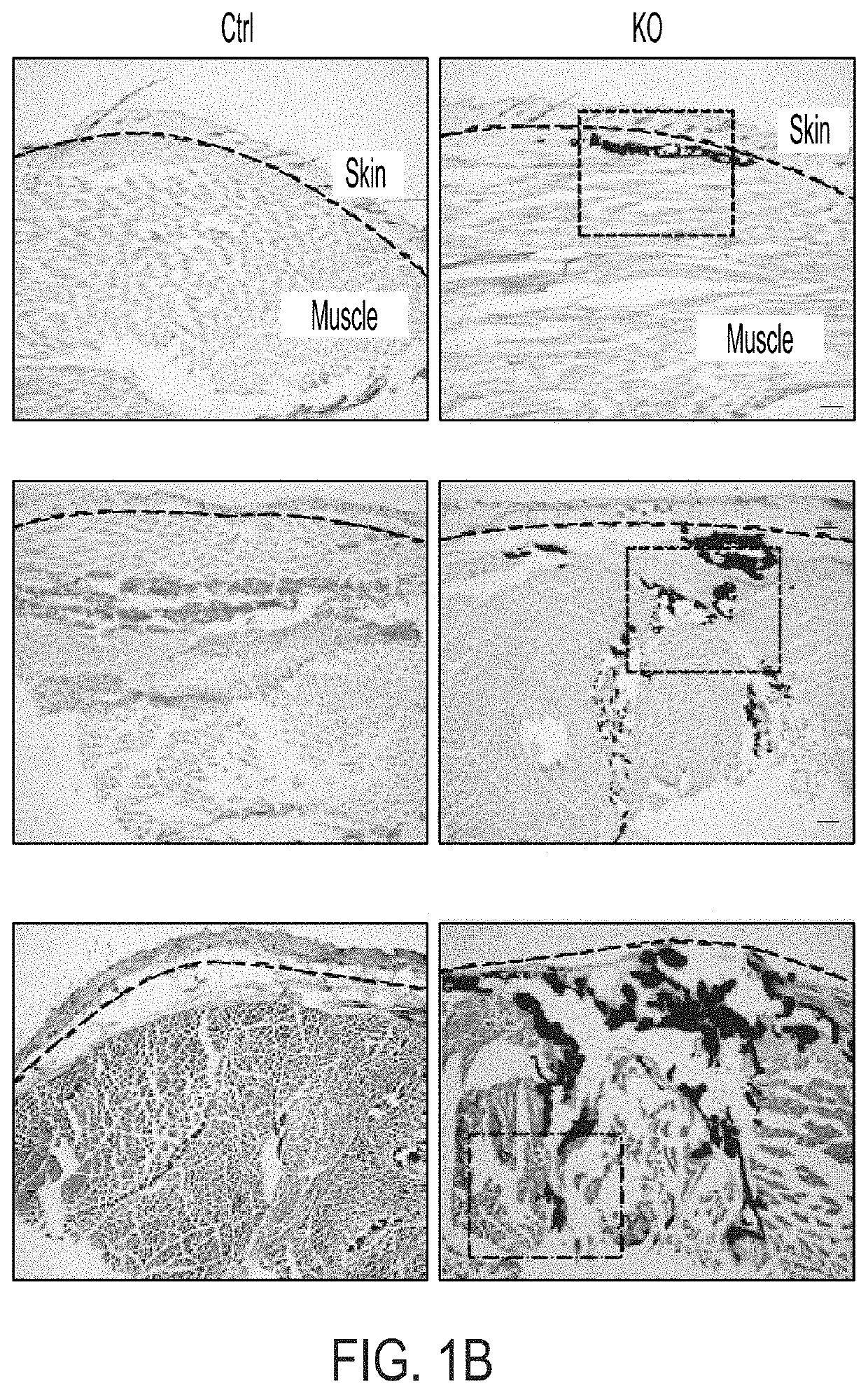Methods and compositions for treating heterotopic ossification
a technology of heterotopic ossification and composition, applied in drug compositions, instruments, material analysis, etc., can solve problems such as life-threatening, chondrocyte or osteoblast inability to form, and limiting to a large extent the range of motion
- Summary
- Abstract
- Description
- Claims
- Application Information
AI Technical Summary
Benefits of technology
Problems solved by technology
Method used
Image
Examples
example 1
ve Expansion of Ectopic Bone in POH is Contributed by Recruitment of Wild Type Cells
[0418]As most heterotopic ossification occurs in adults, a POH mouse model was established by subcutaneously injecting Ad-Cre to the hind limbs of 4-weeks-old Gnasf / f mice, which allows Cre-mediated Gαs inactivation by deleting exon 1 of the Gnas gene (Regard, J. B., et al. Nat Med 19, 1505-1512 (2013)). A critical feature of POH is progressively increased ectopic bone formation, which causes increased pain and motion difficulties. In the Ad-Cre injected Gnasf / f mice, ectopic bone formation was examined by μCT scanning and von Kossa staining of the tissue sections (FIGS. 1A and 1B). From 6 weeks to 3 and 8 months post injection, HO expanded progressively from mostly subcutaneous regions, where the Gnas gene deletion was induced by Ad-Cre, to deeper muscle areas (FIGS. 1A and 1B). Quantitative-RT-PCR (QRT-PCR) analysis of osteoblast markers Osterix (Osx) and Collagen 1a1 (Col1a1) also showed that expr...
example 2
Induces Bone Formation Non-Cell Autonomously by Inducing Shh Expression
[0422]To identify the molecular mechanism underlying the cell non-autonomous function of Gnas− / − cells in osteoblast differentiation, WT SNIP cells were cultured with conditioned medium (CM) collected from Ad-GFP or Ad-Cre infected Gnasf / f SNIP cells. Alkaline phosphatase (ALP) and Von Kossa staining was performed to determine osteogenic differentiation and matrix mineralization 7 and 21 days later, respectively (FIG. 2A), and both were enhanced by CM from the Gnas− / − cells. In addition, expression of osteoblast differentiation markers such as Osx and Col1α1 were upregulated (FIG. 2B). These results showed that the Gnas− / − osteoblasts secreted factors to induce osteoblast differentiation of WT cells.
[0423]Previous studies showed that activated Hh signaling was both necessary and sufficient to induce HO in POH (Regard, J. B., et al. Nat Med 19, 1505-1512 (2013)). Hh signaling is controlled non-cell autonomously by...
example 3
Upregulates Shh and Activates Yap Transcription Activities
[0426]To determine the mechanism underlying ectopic Shh expression, RNA seq experiments were performed for WT and Gnas deficient SMP cells (FIGS. 11A and 11B). The Cyclic adenosine 3′,5′-monophosphate (cAMP) signaling was paradoxically upregulated, possibly due to upregulation of some of the negative regulators of cAMP signaling such as Phosphodiesterase 3a (Pde3a). PKA activity, shown by phosphor-Creb levels, was indeed reduced in the Gnas-deficient SMP cells shown by Western blotting analysis (FIG. 2C). Apart from the altered cAMP signaling, Yes-associated protein (Yap) transcription activity was also increased. Yap is a transcriptional factor in the Hippo signaling pathway that critically regulates cell proliferation, differentiation and survival in development and tumorigenesis (Pan, D. Dev Cell 19, 491-505, (2010); Barron, D. A. & Kagey, J. D. Clin Transl Med 3, 25 (2014); Mo, J. S., Park, H. W. & Guan, K. L. EMBO Rep 15...
PUM
| Property | Measurement | Unit |
|---|---|---|
| Composition | aaaaa | aaaaa |
| Protein activity | aaaaa | aaaaa |
| Level | aaaaa | aaaaa |
Abstract
Description
Claims
Application Information
 Login to View More
Login to View More - R&D
- Intellectual Property
- Life Sciences
- Materials
- Tech Scout
- Unparalleled Data Quality
- Higher Quality Content
- 60% Fewer Hallucinations
Browse by: Latest US Patents, China's latest patents, Technical Efficacy Thesaurus, Application Domain, Technology Topic, Popular Technical Reports.
© 2025 PatSnap. All rights reserved.Legal|Privacy policy|Modern Slavery Act Transparency Statement|Sitemap|About US| Contact US: help@patsnap.com



